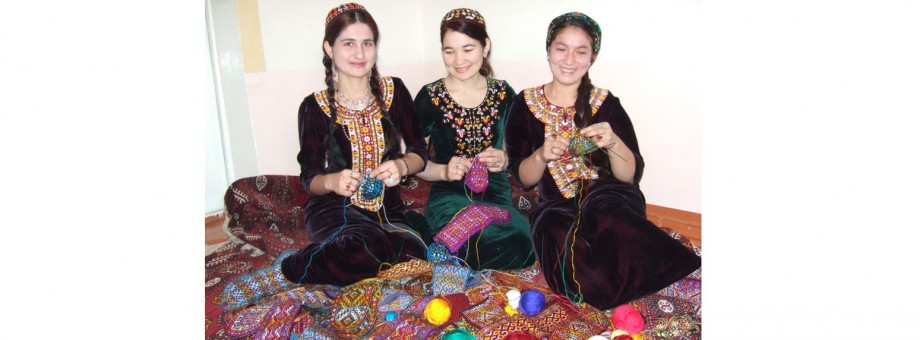HAND-KNITTED TURKMEN SOCKS

Although known to the Turkmens since ancient times, knitting has played a more modest role in folk art than carpet making, embroidery, weaving, and has found its most vivid expression in gülli joraps, socks with ornamental motifs.
Joraps or juraps, thick knitted socks, were very common in countries of Central and Southwest Asia, and Caucasus, which had sources of wool and traditional arts and crafts.
Over many centuries Turkmen knitters have developed their own system of ornamental motifs and various color schemes, which give gülli joraps a distinctive national flavor.
These socks are made from homespun sheep’s wool yarn. Turkmen women processed wool themselves and this process was quite labor intensive. Back in the past, natural plant dyes were used to dye yarn in different colors with chemical dyes commonly used now. Home produced yarn has given place to factory-made yarn with rayon thread for added strength. New characteristics of wool affect the texture of warm socks. Back then, the socks were knitted with homemade wooden knitting needles. Like in the 19th century, metal needles are still used now. Despite a rather simple knitting technique, what sets these socks apart are their special ornamental elements created with a blend of contrasting colors and a traditional geometric pattern. Motifs are very well defined and immensely varied.
Knitted socks are worn both by women and men alike. Like women’s, men’s socks are knitted with the one-color heel. The leg of men’s socks is longer (40-45 cm) than that of women’s. When it is cold, pants are neatly tucked into them. Men’s socks are usually patternless, it is by no means uncommon for them to have patterns, though.
This distinctively Turkmen craft, which was widely practiced in people’s everyday all over the country, has a deep stylistic connection with all other folk crafts. Like gowns, robes, scarves, and jewelry, gülli joraps were an integral part of the traditional women’s outfit making it complete.
Many motifs on knitted socks have their roots in the remote past and some of them were featured on the items unearthed during archeological excavations. For example, gochak, a horn-shaped pattern, the most commonly used in all types of folk art, and alaja, a line with contrasting dots, are very ancient ornaments. Some of knitted motifs were borrowed from embroidery (zigzag and stair-step shaped motifs) and from carpets (a jagged triangular motif). The means of expression are diverse: a blend of contrasting and well-balanced colors, well-defined lines and an eye-catching granular texture.
Woolen and silk socks with a patterned wedge are always knitted with ornamental stripes (layers) of different width. The widest stripe is on the front, which is intricately ornamented with main motifs. Other motifs form a decorative border making the shape of a pyramid. The toe and heel have a triangular shape.
Thanks to this knitting technique, colored yarn creates motifs on the right side of work. Knit stitches run down the length of the socks; purl stiches are on the wrong side and end with several rows.
Deep red, warm claret red, and red are the dominant colors in patterns of most Turkmen socks. To ensure red as a dominant color, to add variety and have a winning color combination, Turkmen craftswomen employ different techniques. They use different colors to knit the same motifs in the pattern in rhythmic succession. The main motifs of these socks are quite big and clearly visible.
In accordance with the custom, jorap socks should not be knitted from camel’s hair yarn since camels are regarded as sacred animals and camel’s hair is not allowed to be stepped on. However, sleeveless cardigans, waist belts (gushak), broad belts, amulets and bracelets, which are very popular with people, have been knitted from camel hair yarn in the past 30-40 years.
Hand-knitted socks have lost none of their importance and are willingly worn today. And still they are closely linked with ancient folk traditions and customs that have partly survived to this day. Silk or woolen socks with bright motifs and intense colors lend a festive appearance to the bride’s traditional wedding attire perfectly complementing it.
These striped socks are knitted in every rural household. Those who live in mountainous areas wear them all year around. These articles of clothing add color to urban dwellers’ homes, delighting the eye with their originality. Despite traditionally established standards, knitters give their individual touch to motifs, creating unique combinations.
These richly ornamented socks have gained in popularity today. What is more, the last 10-20 years have seen a change in the evolution of national dress. A new form of traditional socks has emerged: slipper socks, which are practical and comfortable. Today, Turkmen craftswomen also knit new tiny jorap socks (3-5 cm long) with sewing needles rather than knitting needles. These miniature masterpieces boast true artistry. The variegated and deftly crafted souvenirs can be seen in cars and homes, or as a decoration or an amulet worn on clothes.
An artistic taste, a sense of color and an ability to clearly envision an end product are essential qualities for knitters. They successfully combine the traditional art and new trends in clothes, and modern knitted products lose none of their charm as decorations for national clothes. Hand-knitted gülli joraps are always beautifully elegant and unique.


 NEWS
NEWS